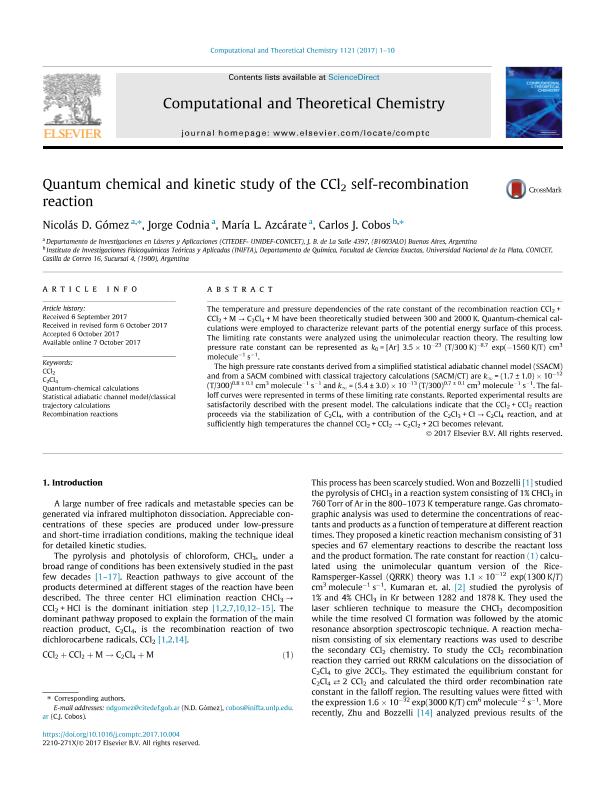Mostrar el registro sencillo del ítem
dc.contributor.author
Gómez, Nicolás Damián

dc.contributor.author
Codnia, Jorge

dc.contributor.author
Azcárate, María Laura

dc.contributor.author
Cobos, Carlos Jorge

dc.date.available
2018-04-09T19:45:34Z
dc.date.issued
2017-12
dc.identifier.citation
Gómez, Nicolás Damián; Codnia, Jorge; Azcárate, María Laura; Cobos, Carlos Jorge; Quantum chemical and kinetic study of the CCl 2 self-recombination reaction; Elsevier; Computational and Theoretical Chemistry; 1121; 12-2017; 1-10
dc.identifier.issn
2210-271X
dc.identifier.uri
http://hdl.handle.net/11336/41412
dc.description.abstract
The temperature and pressure dependencies of the rate constant of the recombination reaction CCl2 + CCl2 + M → C2Cl4 + M have been theoretically studied between 300 and 2000 K. Quantum-chemical calculations were employed to characterize relevant parts of the potential energy surface of this process. The limiting rate constants were analyzed using the unimolecular reaction theory. The resulting low pressure rate constant can be represented as k0 = [Ar] 3.5 × 10−23 (T/300 K)−8.7 exp(−1560 K/T) cm3 molecule−1 s−1.
The high pressure rate constants derived from a simplified statistical adiabatic channel model (SSACM) and from a SACM combined with classical trajectory calculations (SACM/CT) are k∞ = (1.7 ± 1.0) × 10−12 (T/300)0.8 ± 0.1 cm3 molecule−1 s−1 and k∞ = (5.4 ± 3.0) × 10−13 (T/300)0.7 ± 0.1 cm3 molecule−1 s−1. The falloff curves were represented in terms of these limiting rate constants. Reported experimental results are satisfactorily described with the present model. The calculations indicate that the CCl2 + CCl2 reaction proceeds via the stabilization of C2Cl4, with a contribution of the C2Cl3 + Cl → C2Cl4 reaction, and at sufficiently high temperatures the channel CCl2 + CCl2 → C2Cl2 + 2Cl becomes relevant.
dc.format
application/pdf
dc.language.iso
eng
dc.publisher
Elsevier
dc.rights
info:eu-repo/semantics/openAccess
dc.rights.uri
https://creativecommons.org/licenses/by-nc-nd/2.5/ar/
dc.subject
Ccl2
dc.subject
C2cl4
dc.subject
Quantum-Chemical Calculations
dc.subject
Statistical Adiabatic Channel Model/Classical Trajectory Calculations
dc.subject
Recombination Reactions
dc.subject.classification
Otras Ciencias Químicas

dc.subject.classification
Ciencias Químicas

dc.subject.classification
CIENCIAS NATURALES Y EXACTAS

dc.title
Quantum chemical and kinetic study of the CCl 2 self-recombination reaction
dc.type
info:eu-repo/semantics/article
dc.type
info:ar-repo/semantics/artículo
dc.type
info:eu-repo/semantics/publishedVersion
dc.date.updated
2018-04-09T15:04:44Z
dc.journal.volume
1121
dc.journal.pagination
1-10
dc.journal.pais
Países Bajos

dc.journal.ciudad
Amsterdam
dc.description.fil
Fil: Gómez, Nicolás Damián. Consejo Nacional de Investigaciones Científicas y Técnicas. Unidad de Investigación y Desarrollo Estratégico para la Defensa. Ministerio de Defensa. Unidad de Investigación y Desarrollo Estratégico para la Defensa; Argentina
dc.description.fil
Fil: Codnia, Jorge. Consejo Nacional de Investigaciones Científicas y Técnicas. Unidad de Investigación y Desarrollo Estratégico para la Defensa. Ministerio de Defensa. Unidad de Investigación y Desarrollo Estratégico para la Defensa; Argentina
dc.description.fil
Fil: Azcárate, María Laura. Consejo Nacional de Investigaciones Científicas y Técnicas. Unidad de Investigación y Desarrollo Estratégico para la Defensa. Ministerio de Defensa. Unidad de Investigación y Desarrollo Estratégico para la Defensa; Argentina
dc.description.fil
Fil: Cobos, Carlos Jorge. Consejo Nacional de Investigaciones Científicas y Técnicas. Centro Científico Tecnológico Conicet - La Plata. Instituto de Investigaciones Fisicoquímicas Teóricas y Aplicadas. Universidad Nacional de La Plata. Facultad de Ciencias Exactas. Instituto de Investigaciones Fisicoquímicas Teóricas y Aplicadas; Argentina
dc.journal.title
Computational and Theoretical Chemistry
dc.relation.alternativeid
info:eu-repo/semantics/altIdentifier/doi/http://dx.doi.org/10.1016/j.comptc.2017.10.004
dc.relation.alternativeid
info:eu-repo/semantics/altIdentifier/url/https://www.sciencedirect.com/science/article/pii/S2210271X17304425
Archivos asociados
